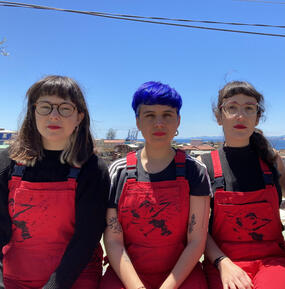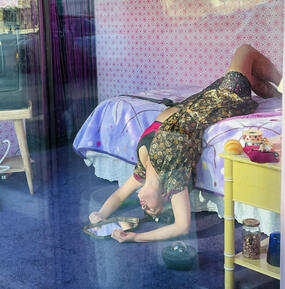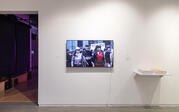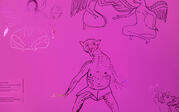for the sake of dancing in the street
Text by Lila Nazemian, commissioned on the occasion of the exhibition.
for the sake of dancing in the street brings together work by LASTESIS, Morehshin Allahyari, and Yasmine Nasser Diaz, alongside installations, videos and research by Ava Ansari, Caitlin Abadir-Mullally, GeoChicas, and Raja Bella Hicks. The title of the show refers to a line in Shervin Hadjipour’s Grammy-Award winning song, Baraye, composed during the ongoing feminist uprising/revolution in Iran following the killing of Jina “Mahsa” Amini on September 16, 2022. Although these artists’ works emerge from various geographical and cultural contexts, they share an array of connections that include the use of archives, considering society’s relationship with technology, and an engagement with the body as a site of both personal and collective protest.
The incorporation of archives as a source material serves as a powerful tool for social critique, and a lens from which to reframe current-day relationships to history. Yasmine Nasser Diaz’s For Your Eyes Only (FYEO) (2019-ongoing) is an installation informed by the private and public struggles for bodily autonomy by women, queer and trans communities from the Southwest Asian North African (SWANA) region and diaspora. Amidst the furniture and other belongings, a video montage of news clips plays on a ‘90s-era television set plays a montage of women-led political rallies from the Global South alongside speeches by politicians from the 1950s to 2021. Women’s voices from across the region and beyond are centered at the forefront of their ongoing struggles to end discrimination.
LASTESIS video, un violador en tu camino: aproximación a una cartografía (a rapist in your path: a mapping approach) includes recordings of performances from around the globe of their street protest, Un violador, en tu camino (A rapist in your path). The Chilean feminist collective’s 2019 protest performance of Un violador went viral and sparked a ripple effect among feminist groups around the world, who re-staged and re-interpreted the dance to address specificities from their local contexts. This work is a testament to new forms of collective partnerships and empowerment through art activism. By linking these divergent performances, it codifies the current era within feminist history as a nonhierarchical, transnational phenomenon. In conversation with their works is an interactive map by GeoChicas chronicling all the locations where Un violador was performed, as well as an installation of archival materials, gathered by Caitlin Abadir-Mullally and Raja Bella Hicks, related to localized protests.
Morehshin Allahyari’s works, in turn, emerge both from historical archives and out of the artist’s own archival project. The Queer Withdrawings (2021) is a vinyl installation of drawings found in archival manuscripts of West Asian and Islamic mythology. They were directly sourced from Allahyari’s, She Who Sees the Unknown (2016–2021), an annotated and illustrated trilingual archive of manuscripts and other sources, assembled over the course of five years. Throughout her work she encountered various issues related to obtaining materials that were not digitized, transcribed or translated, or that were made inaccessible by institutional gatekeeping.
Central to Allahyari’s works is the concept of “Digital Colonialism,” coined and developed by Allahyari addressing institutional use of information technologies that reproduce colonial power structures. Parts of her archive are free and open-source in Arabic, English and Persian, while other sections are only accessible to viewers who can read Arabic or Persian. The archive is itself a deliberate political act that challenges resource hoarding and thwarts the frequent refusals by predominantly Western libraries and museums to reproduce and distribute historical manuscripts. Her archive highlights the potential for technology to play a larger role in preserving and making accessible archives to broader audiences.
The use of VR and other interactive technologies within Allahyari’s work furthermore reverses the assumed incompatibility between history and technology. Zoba’ah (زوبعة): The Whirlwind (2022) is a virtual sculpture based on a jinn whose presence is associated with the sudden onslaught of change. Jinn are sentient beings made of smokeless fire that can influence humans in their plane of existence. Viewers are invited to download the AR artwork after agreeing to a set of terms that involve implementing positive actions in the world. The body manifests itself in Allahyari’s work through the artist’s choice of establishing a collection of images from the manuscripts in her archive focused on female and queer figures, talismans, and the occult sciences.
A second video within Nasser Diaz’s FYEO installation features a collage of Instagram stories and TikTok clips that women and non-binary individuals from the SWANA diaspora posted of themselves dancing. The individuals in the selfie videos emit an air of confidence, sensuality, and an overall sense of playfulness. While social media can be an open space where communities from these diasporas can express themselves, it can conversely be a dangerous space used to shame and threaten them. By projecting this alongside the video of women-led protest movements from the region, Nasser Diaz grounds the inseparability of individual battles for personal freedoms from collective struggles for justice and bodily autonomy.
Similarly, a seminal tenet of LASTESIS’ performance is to push feminist values and concepts beyond the classroom into the street and as such, into the everyday lives of people everywhere. Through the extensive sharing of the performance via social media, this collective movement has not only exposed the pervasiveness of rape culture around the globe but also emphasized the continued defiance of women from within their own homes and societies. LASTESIS’ movement was able to achieve such widespread impact due, in part, to the simple yet powerful lyrics that accompany their dance. Translated and adapted in over 22 languages, perhaps the most poignant verse is: “Y la culpa no era mía ni dónde estaba ni cómo vestía (And it wasn't my fault not where I was nor what I wore),” as it confronts the infuriatingly common and unjust tactic of blaming women as being at fault for the violence they experienced.
Female and non-gender conforming bodies are often subjected to acts of control in the violent forms of abuse, rape, and femicides. The chant condemns the state and broader society as implicit in the daily violence and rape against women and the dance sequence incorporates humiliating poses that Chilean women were subjected to by the police. Nasser Diaz invokes these risks as linked to protests both within her videos, as well as through various objects in her installation that signal measures to safely protest. In LASTESIS’ performance, dance is a tool through which to convey empowering ideologies, while dancing in Nasser Diaz’s FYEO in a form of reclaiming sensuality and expanding upon the limits of cultural approval. Ava Ansari’s G-ray Area (2021) consists of three recordings documenting distinct performances she conducted at FYEO’s iteration at the University of Michigan’s Institute for the Humanities Gallery. Ansari’s work activates the installation by revisiting somatic, sonic, and scenic memories from her past living in Iran.
The works in for the sake of dancing in the street center the body as a vessel that holds within it a multiplicity of simultaneous realities; from powerful and gentle, to subjugated and resilient, both subject and object, yet neither strictly feminine nor masculine. The force of collective presence has the potential to invoke change in one's own community and to destabilize existing patriarchal power structures across global institutions. Individual and collective activism, social justice, and the fight for bodily autonomy form an intertwining constellation that continue to guide burgeoning feminist movements through embodied transmissions of knowledge.





















